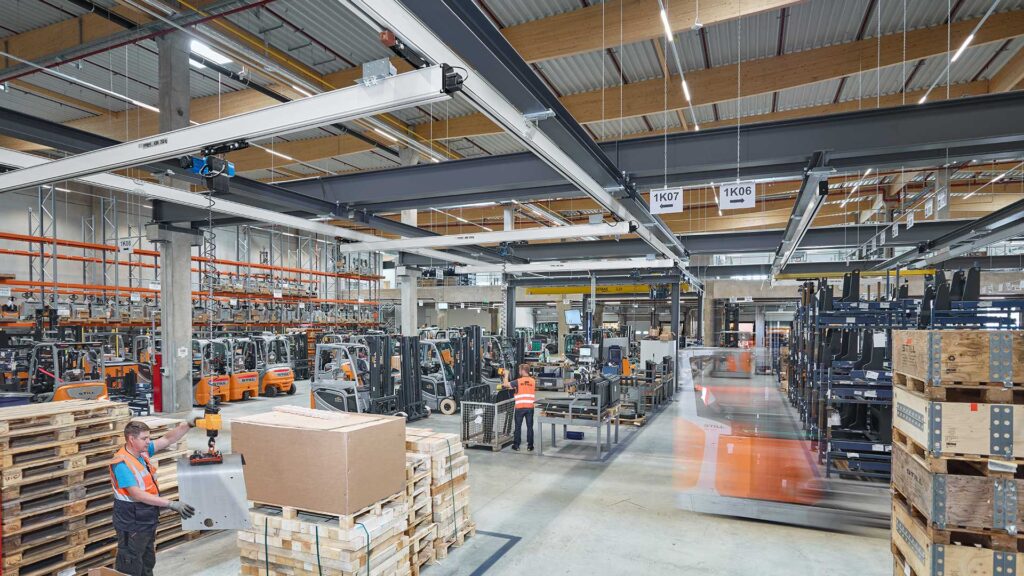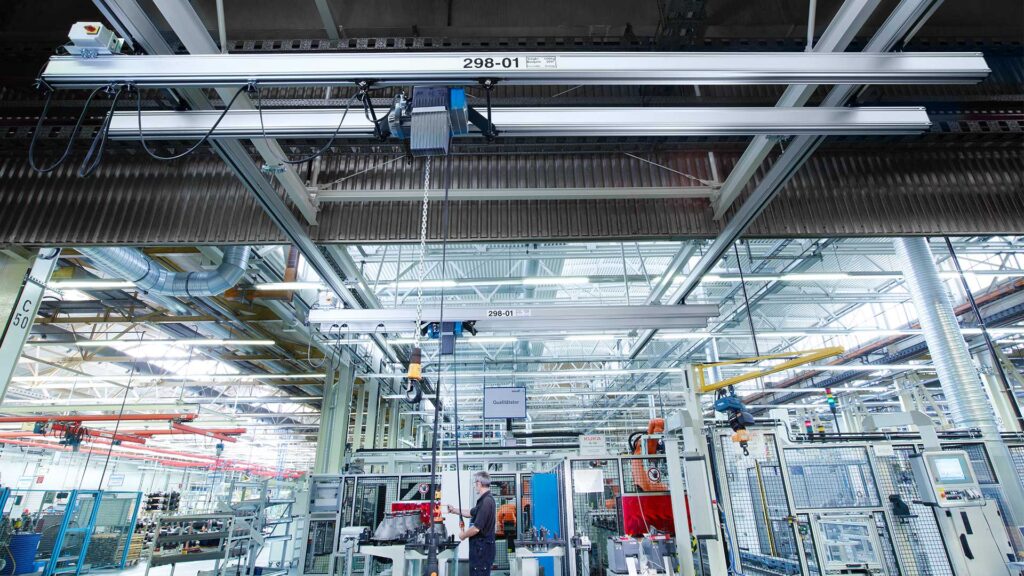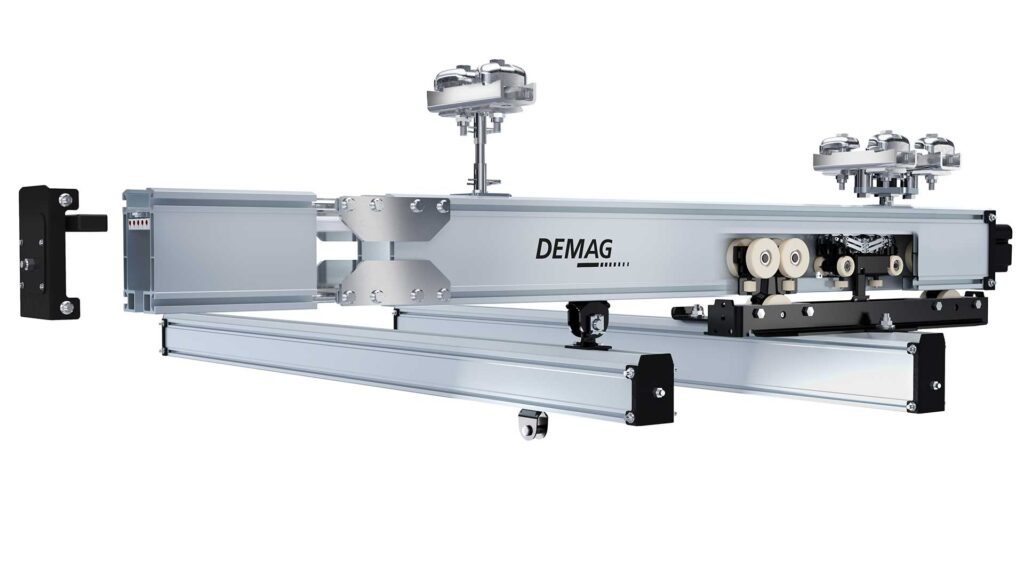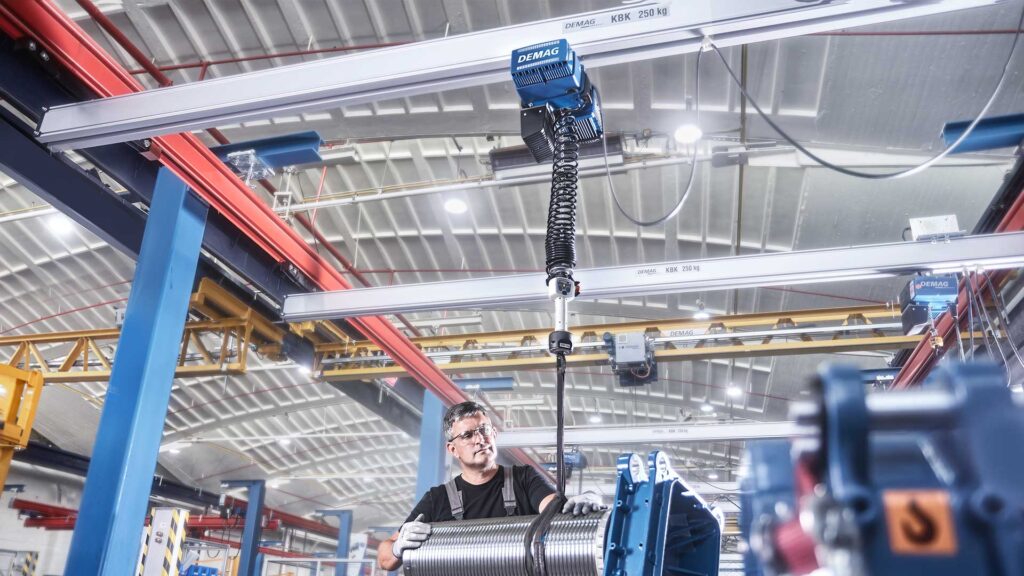Aluminum workstation cranes are essential in modern manufacturing facilities. Known for their lightweight structure, durability, and flexibility they bring many ergonomic and productivity benefits to your material handling process. The ergonomic benefits of aluminum track align with the Occupational Safety and Health Administration’s (OSHA) guidelines for ergonomic lifting. Read on to see the advantages of workstation cranes, focusing on the ergonomic benefits and broader operational improvements they can make in manufacturing facilities.
What is an Aluminum Enclosed Rail Workstation Crane?
Aluminum enclosed rail cranes are overhead crane systems that utilize aluminum tracks to support and move loads. Typically comprised of aluminum track, trolleys, a hoist, and support structures, the lightweight nature of aluminum allows for easier maneuverability when compared to steel. It can also be easier to install by your provider.

The Ergonomic Benefits of Aluminum Cranes
Lightweight and Easier Handling
A primary benefit of aluminum workstation cranes is that aluminum is lightweight by nature. It is approximately one third the weight of steel, significantly reducing the physical strain on workers during installation and operation. Lighter weight translates to lower force requirements when moving the crane, reducing the risk of musculoskeletal disorders (MSDs) among workers.
Reduced Physical Strain
Significant physical effort is often involved with traditional lifting methods such as manual lifting. These types of lifting lead to fatigue and potential injury. Aluminum cranes minimize the risks by providing mechanical assistance and reducing physical strain on workers. The smooth rolling movement of the crane bridge and runways with aluminum track allows for effortless handling of heavy loads and enhances worker comfort and safety.
Compliance with OSHA Ergonomic Guidelines
OSHA, the Occupational Safety and Health Administration, has established guidelines for ergonomic lifting to help prevent work related MSDs. According to OSHA, ergonomic lifting involves reducing the physical demands on workers, like forceful exertions, repetitive motions, and awkward postures. Aluminum workstation cranes align with these guidelines by minimizing the need for manual lifting and ensuring smoother, more controlled movements.
According to OSHA, the leading causes of workplace injuries in industries involving manual material handling are overexertion and repetitive motion. Implementing ergonomic solutions can significantly reduce the risk of injuries and improve overall worker well-being.

OSHA Ergonomic Recommendations and Aluminum Cranes
Minimize manual lifting tasks is recommended by OSHA to reduce the risk of overexertion injuries. Aluminum workstation cranes eliminate the need for manual lifting by providing mechanical assistance for moving and handling heavy loads. Pushing or pulling heavy objects can lead to musculoskeletal injury. Overhead cranes like aluminum cranes are lightweight and smooth rolling to reduce the force necessary to move a load. Reducing awkward movements and reducing the need for reaching and bending allow workers to maintain better posture during work. Aluminum track workstation cranes allow for ergonomic lifting by maintaining neutral postures to prevent strain on the body.
Demag KBK Aluminum Workstation Cranes Bring These Benefits and More
Increased Productivity
Demag Aluminum workstation cranes can significantly enhance productivity in manufacturing facilities. The ease of movement, smooth rolling, and precise control enable faster and more efficient material handling processes. Workers can complete tasks quicker and with less effort, leading to increased overall productivity.

Enhanced Safety
Safety is a top concern for manufacturers. Aluminum cranes, like KBK Aluminum workstation crane systems, contribute to a safer workplace by reducing the risk of injury associated with manual material handling. Smooth rolling and controlled movements can minimize accidents and MSDs.
Flexible and Versatile
KBK is modular so it’s highly versatile and customizable. It’s easy to reconfigure and expand to your changing process needs. KBK systems have the industry’s largest catalog of standard options to further adapt the crane system to meet your requirements. Flexibility ensures your facility can be optimized for your material handling processes and be responsive to evolving demands.
Optimized Uptime
Unlike steel, aluminum is durable and resistant to corrosion and rust making it an ideal solution for overhead cranes. Enclosed track crane systems by nature repel outside particles off the areas where trolleys and bridges run. Demag KBK Aluminum Track is coated inside and outside to add an additional barrier. This reduces the need for frequent maintenance and repair so your operations continue to run smoothly and efficiently.
Common Manufacturing Industries that Use Enclosed Track Cranes
The most common manufacturing thought of in the automotive industry is the assembly line operations auto OEMs use to produce vehicles. Demag KBK Crane and Monorail Systems have been installed in these applications for precision and efficiency. Aluminum rail makes material handling motions more ergonomic and reduces physical strain on the workforce.
The aerospace industry needs to handle large and delicate components with high precision. Aluminum cranes provide the control needed for these components to move safely. The reduced weight aluminum track, like KBK Aluline, is lighter than a steel crane to minimize the load on the support structure. With the wide catalog of options available from KBK, the ultimate in flexibility can be achieved even in applications with space constraints and complex workflows.
Key Considerations for Implementing Aluminum Workstation Cranes

Conducting a thorough assessment of your requirements is key. Factor such as the weight and size of loads, layout of your facility, and required lifting capacities at different locations of the process should be carefully evaluated. Work with a manufacturer to design the system tailored to your operational needs. Work with an experienced manufacturer and/ or dealer to design the system tailored to your requirements. Collaborating ensures the final system will meet the industries and your operational goals for safety and performance. Once installed, operators should receive comprehensive training. In addition, performing regular and periodic maintenance and inspection will ensure your crane system will remain in optimal, safe condition.
Aluminum workstation crane systems, like Demag KBK Aluline Systems, offer your manufacturing facility benefits ranging from ergonomic advantages to increased productivity and safety. These cranes are lightweight and meet OSHA ergonomic guidelines to create a safer, more efficient and productive work environment. Talk to your trusted crane dealer to design a system that works for you!
